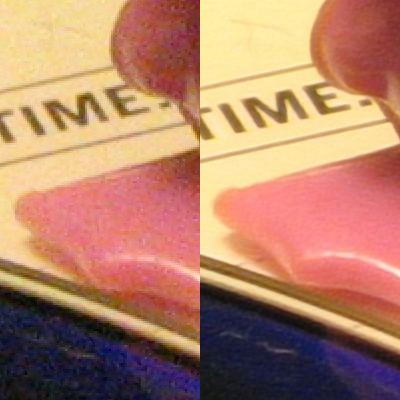Super-resolution
From Wikipedia, the free encyclopedia
| This article includes a list of references or external links, but its sources remain unclear because it lacks inline citations. Please improve this article by introducing more precise citations where appropriate. (March 2008) |
Super-resolution (SR) are techniques that in some way enhance the resolution of an imaging system. There are different views as to what is considered an SR-technique: some consider only techniques that break the diffraction-limit of systems, while others also consider techniques that merely break the limit of the digital imaging sensor as SR.
There are both single-frame and multiple-frame variants of SR, where multiple-frame are the most useful. Algorithms can also be divided by their domain: frequency or space domain. By fusing together several low-resolution (LR) images one enhanced-resolution image is formed.
Contents |
[edit] The necessity of aliasing
In the most common SR algorithms, the information that was gained in the SR-image was embedded in the LR images in the form of aliasing. This requires that the capturing sensor in the system is weak enough so that aliasing is actually happening. A diffraction-limited system contains no aliasing, nor does a system where the total system Modulation Transfer Function is filtering out high-frequency content.
[edit] Breaking the diffraction limit
There are also SR techniques that extrapolate the image in the frequency domain, by assuming that the object on the image is an analytic function, and that we can exactly know the function values in some interval. This method is severely limited by the noise that is ever-present in digital imaging systems, but it can work for radar, astronomy or microscopy.
[edit] See also
[edit] References
- Z. Zalevsky and D. Mendlovic (2003), Optical Superresolution, Springer. ISBN 0-387-00591-9
- J.N. Caron, "Rapid supersampling of multiframe sequences by use of blind deconvolution," Optics Letters, September, 2004, Vol 29, No. 17, p. 1986-1988.
- G.T. Clement, J. Huttunen, and K. Hynynen, "Superresolution ultrasound imaging using back-projected reconstruction" Journal of the Acoustical Society of America, Volume 118, Issue 6, pp. 3953-3960, 2005.
- V. Cheung, B. J. Frey, and N. Jojic. "Video epitomes". In Proc. IEEE Conf. on Computer Vision and Pattern Recognition (CVPR), 2005.
- M. Bertero and P. Boccacci. "Super-resolution in computational imaging". Micron, 34:265–273, October 2003.
- S. Borman and R. Stevenson. Super-resolution from image sequences — a review. Technical report, University of Notre Dame, 1998.
- S. C. Park, M. K. Park, and M. G. Kang., "Super-resolution image reconstruction: a technical overview", IEEE Signal Processing Magazine, 20(3):21–36, May 2003.
- S. Farsiu, D. Robinson, M. Elad, and P. Milanfar. "Advances and Challenges in Super-Resolution", International Journal of Imaging Systems and Technology, Volume 14, no 2, pp. 47-57, August 2004
- M. Elad and Y. Hel-Or, "Fast Super-Resolution Reconstruction Algorithm for Pure Translational Motion and Common Space-Invariant Blur ", IEEE Trans. on Image Processing, Vol 10, No 8, pp. 1187–1193, August 2001.
- M. Irani and S. Peleg, "Super Resolution From Image Sequences" ICPR, 2:115--120, June 1990
- F. Sroubek, G. Cristobal, and J. Flusser, "A Unified Approach to Superresolution and Multichannel Blind Deconvolution", IEEE Trans. Image Processing, vol. 16, pp. 2322-2332, 2007
[edit] External links
- MDSP RESOLUTION ENHANCEMENT SOFTWARE — An implementation of several algorithms on Color and B&W data sets.
- SR GUI in Matlab — Super-resolution software that includes both geometric and photometric registration (only for Windows).
- Video super-resolution using video epitomes.
- MDSP — a MATLAB package for super resolution reconstruction from video.
- What is super-resolution? – an article with step-by-step example of 4x video upsizing using super resolution approach.
|
||||||||||||||


